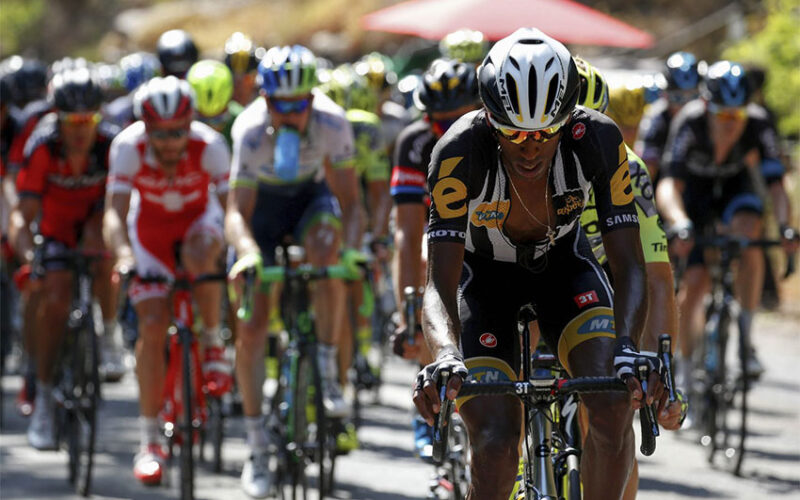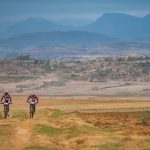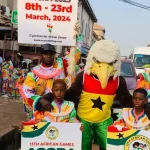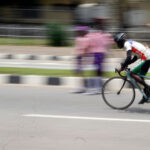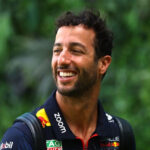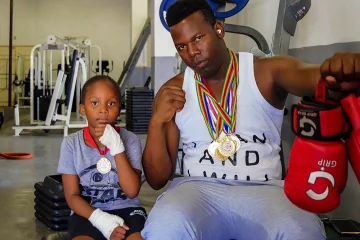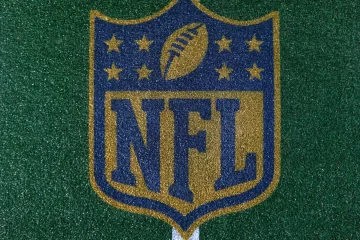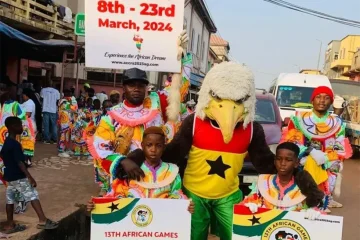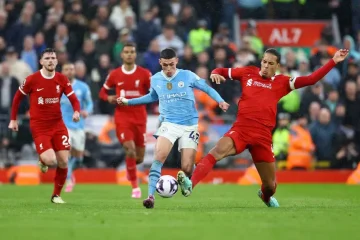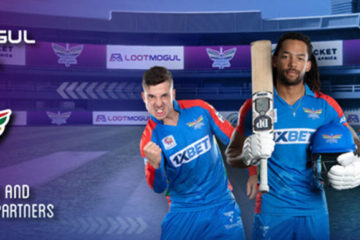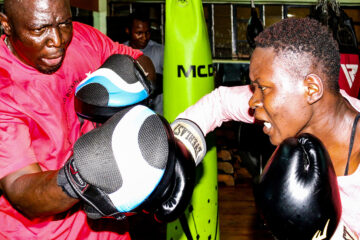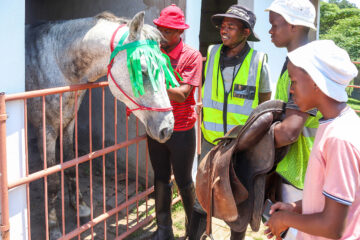DANIEL GALLAN
DOUG RYDER and his Team Qhubeka Assos riders put the continent on the cycling map. He explains why the future of African cycling is bright despite the name changes and struggles of the past.
When Daniel Teklehaimanot of Eritrea pushed off to begin the 2015 Tour de France, he became the first Black cyclist from Africa to compete in cycling’s marquee event. It wasn’t the only first, though, throughout the 102nd edition of the Tour.
Along with countryman Merhawi Kudus, Teklehaimanot wore the black-and-white stripes of MTN-Qhubeka, the first team from Africa to take part. Teklehaimanot would don the King of the Mountain polka-dot jersey for four stages. British rider Steve Cummins claimed victory in stage 14 for MTN-Qhubeka on 18 July, Nelson Mandela’s birthday, fulfilling a pre-race promise made by team principal Doug Ryder.
This was a landmark moment in a sport that has long been the domain of wealthier nations. Elite cycling is an expensive endeavour and successful athletes tend to be born to the saddle. Ryder and his riders – comprising five Africans in a team of nine – not only kicked the establishment’s door down but also took ownership of a seat at the main table by finishing fifth in the final classification. That the team was intrinsically linked with Qhubeka, a South African charity founded in 2005 that has donated more than 100 000 bicycles to improve mobility in impoverished communities, added to the feel-good factor.

Those hoping for a deluge from the floodgates would soon be disappointed. Information technology firm Dimension Data became a title sponsor the following year as the team adopted a more global presence. But three Africans – Teklehaimanot, Natnael Berhane of Eritrea and South Africa’s Reinardt Janse van Rensburg – represented the continent’s only team in 2016. And only three South Africans – Janse van Rensburg, Jaco Venter and Jay Thomson – rode on behalf of Qhubeka between 2017 and 2019.
Following a rebrand in 2020 to Team NTT, named after the Japanese telecommunications giant and holding company of Dimension Data, “Qhubeka” was removed from the title. That South Africa’s Ryan Gibbons was the lone African in the team last year demonstrated the stark contrast to that heady inauguration in 2015.
But the wheels of change are turning again. A new partnership with Swiss cycling apparel manufacturer Assos has seen yet another rebrand. The team has returned to its core principles and will now ride under the moniker Team Qhubeka Assos.
“We always wanted this team to be Qhubeka and we’re keeping that dream alive,” says Ryder, the captain of the South African national cycling team between 1993 and 2002, who partnered with the charity in 2010 with the aim of providing a platform for its work. “It’s important we continue that. It’s important for the UCI [Union Cycliste Internationale, the governing body of world cycling]. Africa doesn’t have an elite team other than us. It’s been a tough time, but we’re back where we need to be.”
To understand where African cycling is going, it is important to know where it has come from. In South Africa, Chinese migrants who were shipped across the world to work on the mines in the early 1900s brought bicycles with them. This cheap mode of transport was adopted by the Black population, who called their bikes qhubekas, which means to go forward in Nguni languages. But this clunky contraption was never more than a means to an end. It was associated with a hard life and was therefore undesirable.

Cycling’s history in Africa
“For a long time, people in villages thought that bicycles were only for poor people,” says Qhubeka founder Anthony Fitzhenry. “It wasn’t a good look to be seen riding one around.”
A different narrative unfolded on the Horn of Africa, where Italian colonisers gave the bicycle an air of modernity. Eritreans in particular took to the sport. The country’s capital of Asmara sits 2 350m above sea level and its dry conditions and mountainous terrain proved a perfect breeding ground for elite cyclists. Eritrea hosted its first annual cycling competition in 1937 and Ghebremariam Gebru beat a field filled with Italians two years later to claim victory.
Accounts vary but it is estimated that the British transported between 90 000 and 120 000 Italian prisoners of war to South Africa. Most were dumped in a detention camp in Zonderwater, 43km east of Pretoria, during World War II. Many of the soldiers were either East African conscripts or had served in the region and, despite appalling living conditions, maintained their strong cycling tradition.

Like everything else in apartheid South Africa, one’s relationship to the bicycle depended on which side of the unbreachable socioeconomic divide you were planted. For white people, it was a symbol of freedom and leisure. For the oppressed majority, it was a reminder of their limited aspirations.
“In the early years of democracy, people in rural South Africa understandably wanted to drive a Range Rover or a Mercedes Benz. They didn’t want a bicycle,” Fitzhenry explains. “That was our biggest struggle when we started the charity. Bikes just weren’t cool. We would go into communities to donate bikes and people would tell us, ‘We don’t want those apartheid bikes.’ They were referring to the ugly and heavy Black Mamba roadsters that became associated with their struggle. We couldn’t simply make promises about mobility and freedom of movement. We had to think of an image. That is why Doug’s team has been so instrumental.”
With a professional outfit competing on the grandest stage, cycling began to infiltrate new spaces. “Now, when we go into those same communities, people talk to us about the Tour de France and have their favourite riders,” Fitzhenry says. “Exposure and representation are powerful forces. You can’t fabricate that. It has to be authentic.”
Cycling is a sport that has no room for subjectivity. There are no opinions. All that matters is how fast a cyclist can climb a mountain or sprint to the finish line. As Ryder and his team discovered, African riders were struggling to keep up.
“The biggest challenge is technique and experience,” says Kevin Campbell, team manager of Qhubeka Assos. “European riders are riding in the cold and wet from the age of 13. Many Africans are maybe 21 at the earliest when they experience those conditions for the first time. They’re effectively learning at an elite level what their peers have learned from the time they could ride. That is the challenge.
“The African riders have the engine but they need time to learn these skills. It’s a big ask for them to come to Europe and start winning, which is what many of them expect as they were dominant in their home country. They get disheartened. People on the outside then start to wonder why they haven’t made the step up. They think we’re doing something wrong or question the riders’ ability.”

Keeping African dreams alive
Survival in this world depends on success and Ryder had to dispel sentimentality as he shed African talent from his roster.
“We needed to stay alive and maintain our World Tour ranking,” Ryder says. “Otherwise we don’t exist. If you’re not in the top division, you don’t find partners and it is tough to get back in. It’s a tough circle.
“But unearthing and fielding an African superstar is still the dream. We never created this team to look good in lycra. It was created to create opportunities. We’ve brought, through our continental team and World Tour team, more than 50 riders from Africa. That’s more than Green Edge has done for Australian riders or Sky has done for British riders.”
Some of those riders, such as Teklehaimanot and Berhane, have moved on to other teams. Before the 2015 Tour de France, Ryder reported that several of his Black cyclists from Africa had experienced the odd verbal jab in the peloton that carried racial overtones. Now, he says, that no longer happens. Africans are an accepted norm in the colourful clusters that ride over European mountain ranges and through medieval towns.
Nicholas Dlamini, 25, renewed his contract with the team in November and is an important figure on and off the bike.
“To re-sign with the team is a big relief as it means that the African dream stays alive,” said Dlamini, who spent much of last year recovering from a broken arm inflicted by overaggressive rangers in Table Mountain National Park. “Having Qhubeka back as part of our name is very special and I’m really looking forward to seeing the kit design with the Qhubeka hand on our back. They have always been part of our DNA and very close to our hearts. The focus is of course on winning but also, importantly, on putting children on bicycles, so I know that my teammates and I are suffering out there for a great purpose.”

Ryder was also keen to emphasise that the team’s relationship with Assos provides new opportunities that could establish Qhubeka as a global brand.
“We have the power to create a huge amount of merchandise,” he says, barely containing his excitement. “We are going to create a commercial branch, which has never been seen in cycling before. It’s massive in football and other sports, but not cycling.
“I was speaking with David Lappartient, the president of the UCI, and he said that Qhubeka is a team brand that can stand the test of time. He said how important it is for global cycling. He said that having the name front and centre is a beautiful thing, given the difficult state of the world. The world loves what we are continuing.”

